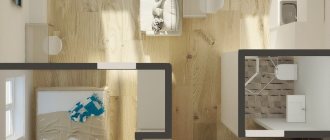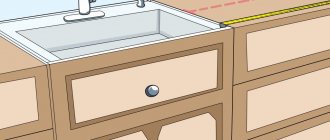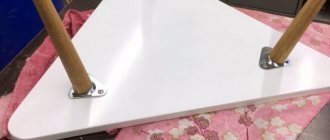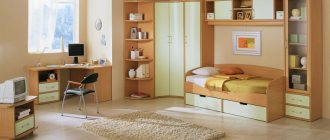Features and advantages of furniture with a built-in computer
The system unit takes up a lot of space, so most often the computer is placed in a desk drawer or placed directly on the floor. This arrangement is not always convenient for the user and is not particularly safe for the PC itself. Recently, the built-in system unit in the table has become especially popular. This design has many advantages:
- attractive appearance;
- no extra wires;
- free space on the floor;
- easy access to components;
- the risk of contamination is lower than with low placement;
- no restrictions on component sizes.
Computer on the table.
What factors to consider when placing your monitor?
Screen height
When it comes to an acceptable screen position, it may vary slightly from person to person. This depends, among other things, on his height. Generally speaking, any screen position that forces you to tilt your chin or otherwise bend or tilt any part of your body is incorrect. These postures can not only cause the aforementioned tension, discomfort, and pain, but they can also affect your productivity.
Distance to screen
Viewing distance directly depends on how far you are from the computer screen. Too far and you won't be able to read freely. Too close and you'll have to deal with eye strain. When it comes to effective positioning, the key is to find a happy medium .
Moreover, distance is not only a problem for the eyes. If you are too close or too far away, you may subconsciously begin to lean back or forward, or stretch your arms too far. The fact is that a small miscalculation in the distance to the screen can ruin all your ergonomic efforts.
To set the ideal distance to the screen , first pay attention to accommodation and convergence of the eyes, which refer to the involuntary functions of the eyes when they are too close to an object. This is what causes eye strain. To avoid this and other similar problems, the solution is quite simple. When sitting in front of a computer screen, simply place the monitor at a length equal to the length of your fully extended arm.
Since computer screen sizes vary, be sure to double-check that your monitor is not too close or too far away. If done correctly, you will be able to see the entire screen and work comfortably without straining your eyes or moving any part of your body.
Viewing Angle
Not only should your computer screen be positioned directly in front of you, but it's also important to know what angle you're viewing it from. Place your computer screen at a bad angle for long enough and you could experience neck pain and possibly even injure it.
When it comes down to it, the angle of the screen more or less matches its height in relation to the user. For example, a person who is 186 cm tall should not have the screen in the same position as a person who is 175 cm tall.
In terms of numbers, your screen should be positioned anywhere from eye level to thirty degrees below your line of sight . This range is determined based on the fact that our eyes naturally stretch forward and downward when at rest.
With this in mind, the way to determine the optimal angle without breaking out a protractor is very simple. When you look at a computer monitor, your eyes should be at rest at the level of the browser's address bar. If this is not the case and you can see the trash can or the top toolbar, you should adjust the angle at which you are looking at the screen.
Ergonomic monitor stand
Ergonomic monitor stands are workplace accessories that aim to take the guesswork out of proper ergonomic screen placement. Thanks to the extendable and tilting bracket, angle, distance and glare issues are quickly resolved.
Ergonomic monitor stands are designed to provide ergonomic comfort to most monitor owners. Using a monitor mount like this will provide a wide range of height and angle adjustments, helping you more easily find the best position for your computer screen.
Dual Monitor Arm
Dual monitor arms, compared to basic ergonomic monitor stands, allow you to place two screens instead of one. With all the same benefits as ergonomic monitor stands, the eponymous dual aspect of these monitor arms is really what makes it interesting.
at least two monitors has recently become increasingly common . Dual monitoring provides the user with the same user experience as a single ultra-wide monitor. As the trend takes hold, research shows that this approach leads to increased user productivity.
From an ergonomics perspective, dual-monitor setups should be treated the same as their single-monitor counterparts— proper placement, spacing, and angle still matter .
Generally speaking, the most important factor in determining proper dual screen ergonomics has to do with the ratio of usage between the two monitors. Those who use both screens equally should treat them the same as a single monitor, with both positioned straight and at arm's length.
On the other hand, those who use one monitor significantly more than the other should pay more attention to the main monitor. A secondary monitor should follow the same rules, but at an angle that favors your dominant eye.
How does a computer work in a desk?
This design involves placing computer components in a horizontal position. Inside the tabletop are all the main components of the system unit:
- motherboard, with processor and RAM;
- video card;
- HDD and SSD drives;
- cooling system;
- power unit;
- Wi-Fi module;
- controllers;
- cable synchronizer.
On the outside of the tabletop there are power buttons and USB connectors. Many models of computer tables are decorated with LED strips, while the surface of the table top is usually made of glass. Thanks to the backlight, the computer in the table looks very stylish and futuristic.
Cool?
Amazing! And how!
Manufacturing materials and consumables
The basis for built-in structures is most often taken from a factory desk or computer desk. The first option is preferable because the working surface is larger. Another plus is that fewer modifications will be required due to the presence of side walls, into which it is convenient to integrate a cooling system and speakers. You can also find table options that have a metal frame completely covered with plexiglass.
What may be required for production:
- plexiglass in two versions - for the back wall, bottom and panels with increased load it is better to choose sheets with a thickness of 10 mm, and for partitions 5 mm is enough;
- self-tapping screws and a heat gun for fastening parts;
- jigsaw;
- drill;
- screwdriver;
- LEDs or LED strip.
How to make a PC case with your own hands
A table with a built-in computer cannot be found on the open market. Such designs can be purchased only from a few large manufacturers on order. The cost of such a table will be significantly higher than that of a regular PC with the same “stuffing”.
If you wish and have basic skills, you can make such a table yourself. There are options for original tables made of glass and metal online, but for beginners it is better to take a regular desk made of wood as a basis.
Manufacturing materials and consumables
To make a table with a built-in computer, you should prepare components for the system unit itself, and a wooden desk, which will become the basis of the future design. During the work process you will also need some tools and consumables:
- plexiglass;
- heat gun;
- self-tapping screws;
- screwdriver;
- drill;
- jigsaw;
- carbon plates;
- dye;
- sandpaper;
- electrical voltage regulator;
- wires;
- coolers;
- speakers;
- LED strip.
Step-by-step manufacturing algorithm
Creating a table with a computer inside is done as follows:
- The first step is to remove the tabletop, from which four 10 cm wide parts are then cut out. Two long ones are cut horizontally, and two short ones are cut vertically.
- On the sides, 6 identical round holes are made for coolers, 3 on each side. They should be located symmetrically, opposite each other.
- If desired, the side supports can be cut slightly at an angle so that they taper towards the bottom.
- All edges of cut parts and holes must be sanded to remove burrs.
- The parts prepared from the tabletop are secured to the base using glue.
- The back of the table is fenced off with a lattice. This section will serve as a cable channel in which all the wiring will be hidden. The width of the cable channel should be about 20 cm.
- After installing all the side panels and the cable channel, it is necessary to clean the inner surface of debris and dust.
- The cleaned surface of the table is painted. Black, matte paint will look best. For complete drying, you must wait 24 hours.
Finishing and lighting
When the paint has dried, you can begin gluing the carbon film. If desired, you can cover the entire surface of the table or individual parts.
| Backlight installation | The next step is to install and connect all the components, after which you can install lighting inside the table. To do this, LED strip is glued around the perimeter. You can also illuminate coolers, video cards and other components inside the table. |
| Lighting power | The backlight switch is located on one of the side panels. If you have the necessary skills, the backlight can be connected directly to the motherboard. This will allow you to control it directly from your computer. |
| Consolidation | When the body of the future computer desk is ready and the components are installed, all that remains is to fix the plexiglass tabletop. The tabletop is secured using transparent glue. |
Additional design elements
To free up additional space on the table surface, you should install a special monitor bracket. You can buy a ready-made device in a store, or make it yourself. Also, for convenience, you can equip the table with a hook or stand for a headset, and a docking station for a mobile phone.
Why glass computer desks are becoming more and more popular
Every year, our customers increasingly decide to buy a glass computer or desk.
What is the reason? Modern fashion dictates its terms not only in clothing, but also in interior design. The only difference: the change of “seasons” in the interior space occurs much more slowly. For most buyers, this is a definite plus, because some trends first need to get used to, and only then bring them into your life. Glass computer tables, as well as for laptops, are a recent innovation that have definitely cemented their position in modern interiors for a long time. Computer desks themselves have long become an obligatory piece of home and office furniture, which was initially more functional than a decorative solution. However, the designers could not come to terms with the massiveness of this type of furniture and wanted to “lighten” it. They succeeded perfectly.
It would seem that glass is an outwardly fragile material. But in our online store you will only find products made of tempered glass, which cannot be broken or damaged . At the same time, computer glass tables have the same functionality as classic wooden tables, but are gradually gaining great popularity. For example, corner glass computer tables are successfully replacing their chipboard “brothers”, which, against the background of glass products, look more massive and rough.
If you are a supporter of modern interior solutions, a fan of “clean” decor, and deep down you dream of Scandinavian design, then you simply need to buy a glass table for your computer or laptop. This purchase will make your interior truly stylish and relevant. You will immediately notice the difference in the increase in space , which was previously hidden by the volumetric predecessor.
Original models of tables with a built-in computer
In recent years, such computer desks have become increasingly popular. Manufacturers are in no hurry to launch mass production of embedded system units, but talented craftsmen create different versions of original designs with their own hands.
Built-in computer.











